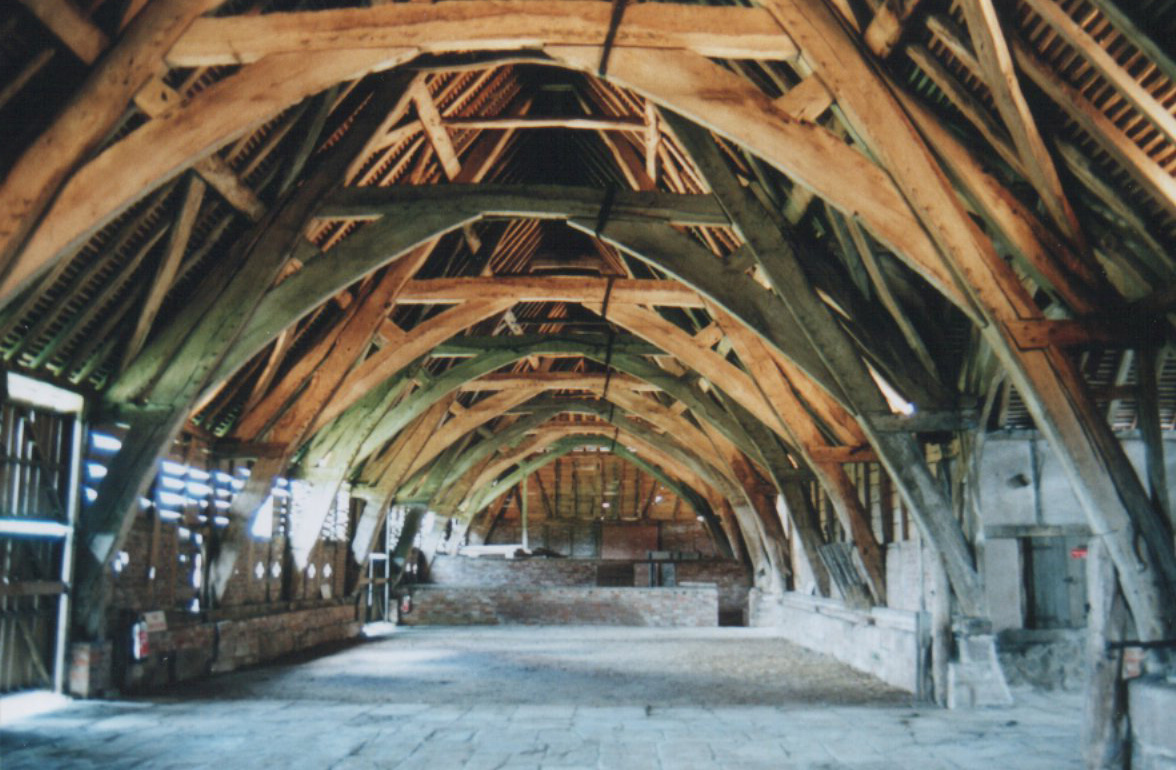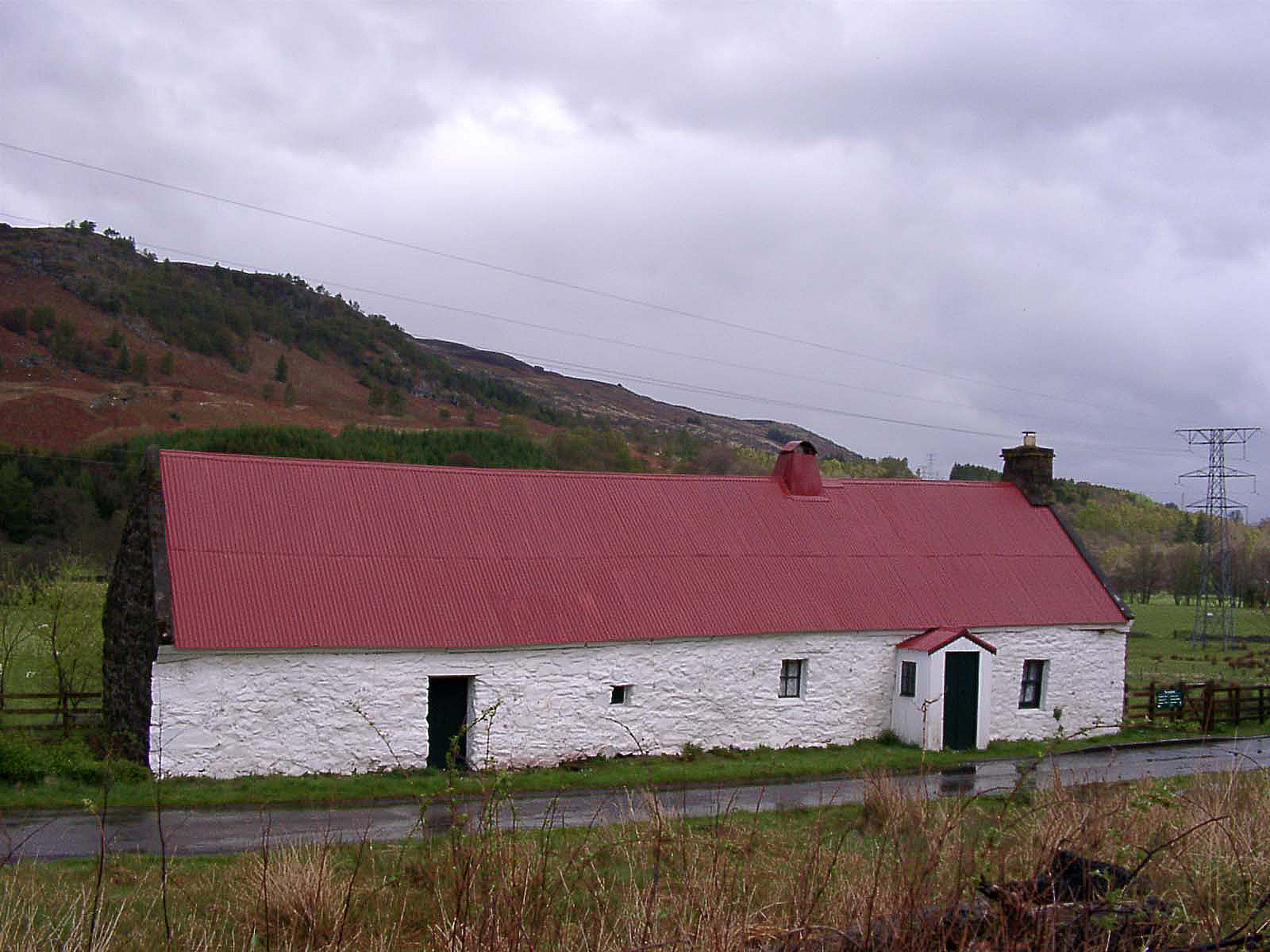Cruck on:
[Wikipedia]
[Google]
[Amazon]

 A cruck or crook frame is a curved
A cruck or crook frame is a curved
 Crucks were chiefly used in the
Crucks were chiefly used in the
Cruck database
Black and White Timber Framed houses
{{Woodworking Woodworking Vernacular architecture Timber framing Structural system

 A cruck or crook frame is a curved
A cruck or crook frame is a curved timber
Lumber is wood that has been processed into uniform and useful sizes (dimensional lumber), including beams and planks or boards. Lumber is mainly used for construction framing, as well as finishing (floors, wall panels, window frames). ...
, one of a pair, which support the roof
A roof (: roofs or rooves) is the top covering of a building, including all materials and constructions necessary to support it on the walls of the building or on uprights, providing protection against rain, snow, sunlight, extremes of tempera ...
of a building
A building or edifice is an enclosed Structure#Load-bearing, structure with a roof, walls and window, windows, usually standing permanently in one place, such as a house or factory. Buildings come in a variety of sizes, shapes, and functions, a ...
, historically used in England and Wales. This type of timber framing
Timber framing () and "post-and-beam" construction are traditional methods of building with heavy Beam (structure), timbers, creating structures using squared-off and carefully fitted and Woodworking joints, joined timbers with joints secure ...
consists of long, generally naturally curved, timber members that lean inwards and form the ridge of the roof. These posts are then generally secured by a horizontal beam which then forms an "A" shape. Several of these "crooks" are constructed on the ground and then lifted into position. They are then joined together by either solid walls or cross beams which aid in preventing 'racking' (the action of each individual frame going out of square with the rest of the frame, and thus risking collapse).
Etymology
The term ''crook'' or ''cruck'' comes fromMiddle English
Middle English (abbreviated to ME) is a form of the English language that was spoken after the Norman Conquest of 1066, until the late 15th century. The English language underwent distinct variations and developments following the Old English pe ...
', from Old Norse
Old Norse, also referred to as Old Nordic or Old Scandinavian, was a stage of development of North Germanic languages, North Germanic dialects before their final divergence into separate Nordic languages. Old Norse was spoken by inhabitants ...
', meaning "hook". This is also the origin of the word "crooked", meaning bent, twisted or deformed, and also the crook used by shepherd
A shepherd is a person who tends, herds, feeds, or guards flocks of sheep. Shepherding is one of the world's oldest occupations; it exists in many parts of the globe, and it is an important part of Pastoralism, pastoralist animal husbandry. ...
s and symbolically by bishops.
Use
 Crucks were chiefly used in the
Crucks were chiefly used in the medieval
In the history of Europe, the Middle Ages or medieval period lasted approximately from the 5th to the late 15th centuries, similarly to the post-classical period of World history (field), global history. It began with the fall of the West ...
period for structures such as houses and large tithe barns, which were entirely timber-framed. They were also often used for the roofs of stone-walled buildings such as churches. However, these bent timbers were comparatively rare, as they were also in high demand for the shipbuilding industry.
Where naturally curved timbers were convenient and available, carpenters continued to use them at much later dates. For instance, base crucks are found in the roofs of the residential range of Staple Inn Buildings, Nos. 337 – 338, High Holborn, London. This is dated by documented records to 1586, with significant alterations in 1886 (under Alfred Waterhouse) and further restorations in 1936, and 1954–55. Despite these changes Cecil Hewett, an authority on English Historic Carpentry, has stated that these 16th-century crucks are original.
The large main barn of the manor house Barlow Woodseats Hall features what is claimed to be the longest continuously roofed cruck barn in Derbyshire, and possibly even in the United Kingdom.
An example of a Yorkshire
Yorkshire ( ) is an area of Northern England which was History of Yorkshire, historically a county. Despite no longer being used for administration, Yorkshire retains a strong regional identity. The county was named after its county town, the ...
cruck barn complete with a heather- thatched roof can be found in Appletreewick. The crucks or cruck "blades" are a single oak tree riven (split) in two to form an equally shaped A frame.
Rare examples of cruck framing are found on continental Europe such as in Belgium, Flanders, Northern France and the Corrèze
Corrèze (; ) is a département in France, named after the river Corrèze which runs through it. Although its prefecture is Tulle, its most populated city is Brive-la-Gaillarde. Corrèze is located in the Nouvelle-Aquitaine region, on the bo ...
region of France. No cruck frames are known to have been built in North America though there are rare examples of what may be an upper cruck or knee rafters.
History
The oldest surviving crucks with dates confirmed by tree ring analysis date from around the middle of the 13th century. They may have declined due to providing an inconveniently shaped space in cases where an upper floor was used.Revival
During the current revival of green-oak framing for new building work, which has occurred mainly since approximately 1980 in the UK, genuine cruck frames have quite often been included in traditionally carpentered structures. There are also some fine, historically authentic reconstructions. For instance, Tithe Barn, Pilton,Glastonbury
Glastonbury ( , ) is a town and civil parish in Somerset, England, situated at a dry point on the low-lying Somerset Levels, south of Bristol. The town had a population of 8,932 in the 2011 census. Glastonbury is less than across the River ...
, whose original roof was destroyed by lightning, has been carefully rebuilt in 2005 from curved oaks. The necessary trees were sought out, using special templates, in English woodlands.
Types
# True cruck or full cruck: The blades, straight or curved, extend from a foundation near the ground to the ridge. A full cruck does not need a tie beam and may be called a "full cruck - open" or with a tie beam a "full cruck - closed". # Base cruck: The tops of the blades are truncated by the first transverse member such as by a tie beam. # Raised cruck: The blades land on masonry wall and extend to ridge. # Middle cruck: The blades land on masonry wall and are truncated by collar beam. # Upper cruck: The blades land on tie beam, very similar to knee rafters. # Jointed cruck: The blades made from two pieces joined near eaves. They can be joined in at least five ways. The apex of a cruck frame also helps to define the style and region of the cruck. Different types include the butt apex, halved, housed, yoke, and crossed forms.See also
* Hammerbeam roof *Vernacular architecture
Vernacular architecture (also folk architecture) is building done outside any academic tradition, and without professional guidance. It is not a particular architectural movement or style but rather a broad category, encompassing a wide range a ...
References
Further reading
* Hewett, Cecil A. (1980), ''English Historic Carpentry'', Philimore, pp 231–233. * Harris, Richard (1978), ''Discovering Timber-Framed Buildings'', Shire Publications Ltd. Princes Risborough, Buckinghamshire. * Alcock, N. W., Barley, M. W. ''et al'' (1996), ''Recording timber-framed buildings - An illustrated glossary'', Council for British Archaeology, York.External links
Cruck database
Black and White Timber Framed houses
{{Woodworking Woodworking Vernacular architecture Timber framing Structural system